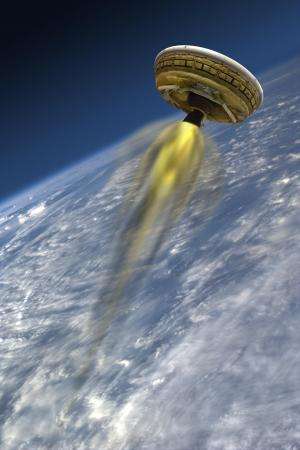This artist's concept shows the test vehicle for NASA's Low-Density Supersonic Decelerator (LDSD), designed to test landing technologies for future Mars missions. A balloon will lift the vehicle to high altitudes, where a rocket will take it even higher, to the top of the stratosphere, at several times the speed of sound. The Low-Density Supersonic Decelerator Project is managed by JPL for NASA's Space Technology Mission Directorate in Washington. Credit: NASA/JPL-Caltech
NASA's Low-Density Supersonic Decelerator (LDSD) project plans to fly its rocket-powered, saucer-shaped landing technology test vehicle into near-space from the U.S. Navy's Pacific Missile Range Facility (PMRF) on Kauai, Hawaii, later this week.
NASA has identified five potential launch dates for the high-altitude balloon carrying the LDSD experiment: June 28, 29, 30, July 1 and 3. The launch window for Saturday, June 28 extends from 8:15 to 9:30 a.m. Hawaii Standard Time (11:15 a.m. to 12:30 p.m. PDT / 2:15 to 3:30 p.m. EDT).
The test will be carried live via Ustream and simulcast on NASA Television.
The vehicle originally was scheduled for its first test flight earlier in June, but unacceptable weather conditions prevented the launch.
Decisions to attempt launch of the LDSD test will be made the day before each launch opportunity date. NASA will issue launch advisories via the mission website, media advisories and on Twitter.
NASA will stream live video of the test via Ustream at: www.ustream.tv/nasajpl2
The video may be intermittent based on test activities. Consult the LDSD website for real-time updates of the test.
More information: More information about the LDSD space technology demonstration mission is online at: www.nasa.gov/mission_pages/tdm/ldsd/
Provided by Jet Propulsion Laboratory
























